The Greening of Berkeley Lab—In the Service of Society
by Dan Krotz
Andy Sessler became the Lab’s third director just two weeks after the start of the 1973 oil embargo, when gas prices soared and lines at gas stations snaked for several blocks. The energy crisis had begun.
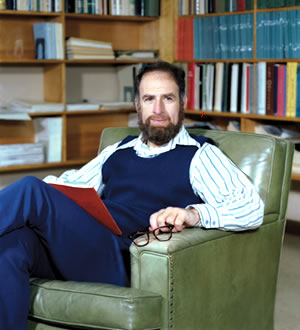
Andrew Sessler, Lab Director 1973-1980.
The 44-year-old theoretical physicist, an avid backpacker and skier who often rode a bike to work, a man of thought and action, was quick to respond. On his first day in office, Nov. 1, 1973, he established the Energy and Environment Division.
The launch of this program marked a turning point in the history of the Lab, which in the 1970s became known as Lawrence Berkeley Laboratory, or LBL for short. The Energy and Environment division joined the Lab’s accelerator, physics, and nuclear chemistry research, and its newer lineup of biology and medical research, and broadened the institution into a truly multidisciplinary operation.
It also meant that improving the world became just as important as understanding it. Sessler viewed the energy crisis and the world’s environmental problems as both a grand challenge for the Lab, and one of the reasons for its existence. In a letter to Lab staff dated the same day he became director, he said “No programs of the Laboratory are more important to its future than those in the fields of energy and environment.” He added that “the purpose and motivation for change at LBL is singular: to bring us closer to the goal that LBL be employed to its fullest in the service of society.”
But it wasn’t any easy road at first. In an Oct. 2, 1973, San Francisco Chronicle article, reporter Charles Petit shed light on what it was like to practice Lawrence’s trademark brand of Big Science in the early 1970s: “He [Sessler] will face problems alien to Lawrence and only lately familiar to [outgoing director] McMillan: a decline in public respect for science, sagging federal support for basic research, and a loss of morale among scientists themselves.”
The article also presaged the changes to come, pointing out that Sessler inherited “the beginnings of a diversification program, away from complete reliance on the big machines and abstract research and toward more ‘relevant’ concerns.”
“It’s the only way this place can stay alive,” Sessler is quoted in the article. “We have to change.”
This change, largely embodied by the Lab’s new focus on energy and environmental research, didn’t occur overnight, nor did it grow in a vacuum. Sessler recalled that it started with a memo he and Ken Watson wrote in 1968, which “called for scientists at the Lab to meet and discuss what could we do about the deterioration of the environment.”
Then-director Edwin McMillan embraced this work, and Nobel Laureate Glenn Seaborg gave Sessler and other initiators, Jack Hollander and Dick Mack, a suite of offices and a secretary. But funding remained scarce.
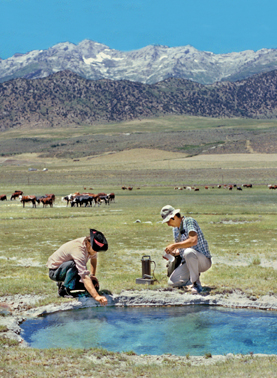
A hot geothermal pool in Ruby Valley, Nevada being analyzed by Lab scientists in a study of geothermal energy sources.
Then, two things occurred that allowed that initial memo to grow into a division. The Atomic Energy Commission (AEC), which funded the Lab, was thrust into the environmental research business when it was ordered to conduct environmental studies prior to the construction of nuclear power plants. And then in October 1973, Egypt attacked Israel, and an Arab oil embargo rattled the nation’s dependence on foreign energy.
Environmental stewardship also rose to the national stage during this time. Earth Day was first celebrated in 1970, confirming a commitment among thousands throughout the U.S. to protect “Spaceship Earth.” This sentiment was echoed in the halls of the federal government in the early 1970s, a period in which the Environmental Protection Agency was established, and the Clean Water and Endangered Species Acts were passed.
With this zeitgeist came federal funding, and the new division prospered. Under the guidance of Hollander, who served as its first director, 56 projects were underway by 1974.
“Those were good times,” recalled Sessler in a recent interview. “The U.S. was developing a national energy plan, and we were one of the few places in the country with the expertise to help.”
In its second year, the division began conservation and energy efficiency research, led by physicists Art Rosenfeld and Sam Berman. Among other accomplishments, Rosenfeld established the Lab’s Center for Building Science in 1975, where a broad range of energy efficiency technologies have been developed, including compact fluorescent lamps and “smart windows” that block heat from entering during the summer or escaping in the winter.
Today, it’s easy to defend the merits of steering Berkeley Lab toward energy and environment research. But not everyone welcomed this new tack in the beginning. Looking back in 1993, Bob Budnitz, the second division director from 1975 to 1978, recalled the skepticism the division faced: “There were many, many people here who felt that what we were doing wasn’t physics and it wasn’t engineering and we shouldn’t be doing it.”
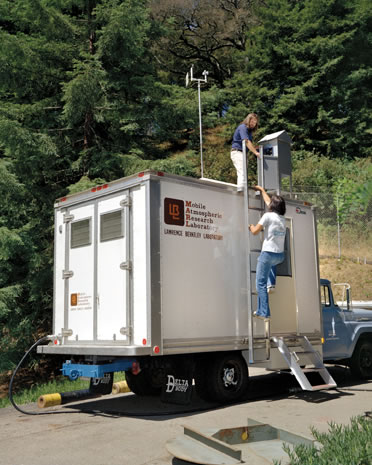
A mobile atmospheric research lab, operated by Craig Hollowell and Greg Traynor, part of the Lab’s air-pollution research program.
Even the AEC balked. After Rosenfeld published several papers that stressed the importance of conservation rather than energy production, AEC officials asked to review all Lab reports prior to publication. Sessler refused to comply, and backed by University of California President Charles Hitch, successfully fought the request. “We’re a science institution, and we needed to be free to publish what we wanted,” recalled Sessler.
Thanks in part to this doggedness, Berkeley Lab’s research portfolio was forever changed. From 1973 to 1980, applied science at the Lab grew to become equal in size to basic research, while basic research maintained a constant level. Today, Berkeley Lab is synonymous with energy-efficient appliance standards, innovative lighting technologies, pioneering atmospheric aerosol and indoor air quality studies, energy use analyses, and better batteries and cleaner combustion technologies.
The boom in applied science also yielded new divisions. In 1977, the Energy and Environment Division (later renamed to today’s Environmental Energy Technologies Division) was split into two, one for energy and environment research and one for Earth Sciences, where scientists tackled seismic research, geothermal energy and the disposal of nuclear wastes. Also in 1977, the Lab’s fusion energy research activities were incorporated into today’s Accelerator and Fusion Research Division.
Like the bumper sticker says, Lab scientists also acted locally. In the 1970s, Lab engineers and computer scientists helped develop and install an improved scheduling system that allowed Bay Area Rapid Transit trains to run more efficiently.
As Berkeley Lab retooled itself to address the nation’s energy problems, so did the federal government. In 1975, the Atomic Energy Commission slipped into history when President Ford signed a measure to form the Energy Research and Development Agency, which began oversight of Berkeley Lab and all AEC Labs. This agency, in turn, changed three years later, when President Carter established the Department of Energy.
Despite Berkeley Lab’s newly minted role as a leader in energy and conservation research, it remained a heavy hitter in physics and other basic research. As Sessler stated in a 1973 memo to Lab staff, “If LBL is to remain the unique national asset that it has been, it must, while executing socially significant research programs, maintain its strong fundamental research base.”
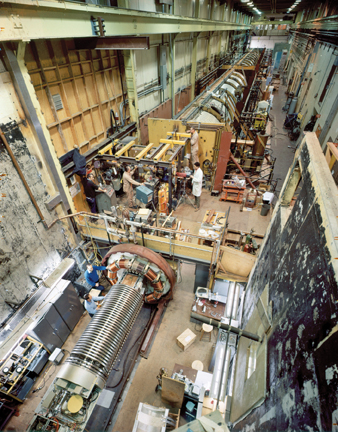
The SuperHilac, successor to the HILAC.
In this vein, the 1970s saw the creation of the super-heavy ion linear accelerator, or SuperHILAC, which could accelerate ions as heavy as uranium. An upgraded version of an accelerator built in 1957, the SuperHILAC opened the door to the creation of synthetic elements beyond uranium, also known as transuranium elements. Seaborgium, one such element, was discovered in 1974 in an experiment conducted at Berkeley Lab by a team of researchers led by Lab physicist Albert Ghiorso and Lawrence Livermore National Lab’s Kenneth Hulet.
Lab physicists, led by Gerson Goldhaber and George Trilling, were also instrumental in the November 11, 1974, discovery of the J/psi particle at the Stanford Linear Accelerator Center (SLAC). This important discovery, which sparked a rapid change in high-energy physics and resulted in a Nobel Prize, would eventually become known as the “November Revolution.” It also led to the construction of an even larger electron-positron collider, called PEP. This project, conducted jointly with SLAC, was one of the biggest undertakings at the Lab in the 1970s, and yielded the first new high-energy accelerator involving the Lab since the Bevatron of the early 1950s.
Also in 1974, Lab physicist Dave Nygren proposed the Time Projection Chamber, a revolutionary system for detecting subatomic particles that remains a mainstay of high-energy physics research at accelerators throughout the world.
And in 1975, the venerable Bevatron, which seemed to be nearing the end of its useful career in high-energy physics, was given a new lease on life by linking it to the SuperHILAC, a concept initiated by Ghiorso and carried out by Hermann Grunder. Nuclei began their journey in the SuperHILAC and then passed through a transfer line to the Bevatron, where they were accelerated to almost the speed of light.
Called the Bevalac, its beams were used to study high-energy nuclear reactions from heavy elements. This research field, christened at Berkeley Lab and led by Art Poskanzer, has spawned nuclear science experiments at Geneva’s CERN and Brookhaven National Lab. Its legacy can also be traced to the construction of the major accelerator at Brookhaven called the Relativistic Heavy Ion Collider.
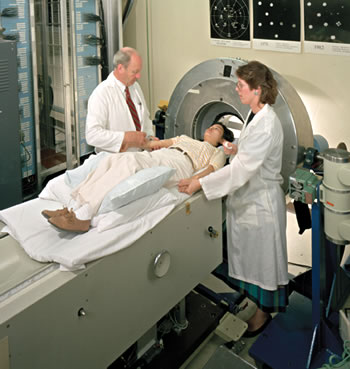
Pioneering research in the 1970s led to this PET scanner, shown with Thomas Budinger, Anna Hashima, and Judy Blair (1988).
Bevalac beams were also found to be useful in the treatment of cancer and other diseases. This work was spearheaded in part by Cornelius Tobias’ research group, which took advantage of the fact that a heavy ion beam can destroy a tumor without seriously damaging surrounding tissue. In 1976, their investigations culminated in an intensive cancer treatment program in collaboration with physicians at the University of California, San Francisco.
In another medical development, Berkeley Lab scientists helped transform Lab scientist Hal Anger’s 1950s-era scintillation camera, which enables physicians to detect tumors using radioactive isotopes, into modern imaging systems. Gated heart single gamma tomography was developed in 1974, and dynamic, gated Positron Emission Tomography (PET) was developed in 1978. This work led to the highest resolution PET scanner in the world, the 2.6 millimeter-resolution camera, which was built by Berkeley Lab’s Thomas Budinger, Steve Derenzo and Ronald Huesman in 1986.
Berkeley Lab also acquired two large electron microscopes, led by Gareth Thomas, which helped cement the Lab as a leader in materials sciences. These machines have since given way to much more advanced microscopes at the Lab’s National Center for Electron Microscopy, which was established in 1983.
To foster innovative research, Sessler also started a Director’s Fund, which became the Laboratory Directed Research and Development Program. The fund enables the director to distribute funds from the overhead budget to select research projects. “We gave precedence to initiatives that looked interesting,” says Sessler.

The Time Projection Chamber, shown with inventor David Nygren (left), was designated for use at the positron-electron colliding beam ring at Stanford.
One of these “interesting” projects led to the 1979 discovery by Nobel Laureate Luis Alvarez that an asteroid impact killed the dinosaurs. Alvarez, working with his son, geologist Walter Alvarez, and nuclear chemists Isadore Perlman, Frank Asaro and Helen Michel, used neutron activation analysis to detect unusual amounts of iridium in Italian Cretaceous-Tertiary boundary sediments. Because iridium has a very low abundance on earth, they attributed the excess iridium to an impact from a 10-kilometer diameter asteroid.
Another Director’s Fund project helped make Hawaii’s Keck Telescope one of the most powerful in the world. At the heart of the telescope is a segmented mirror design that was proposed and developed by Lab astrophysicist Jerry Nelson.
The Lab’s research bonanza in both fundamental and applied science translated to growth. From 1973 to 1980, its budget increased from about $42 million to $142 million annually, and the number of employees jumped from about 2,000 to 3,000. In another sign the Lab had “arrived,” it became a stop on celebrity tours: the Dalai Lama and Prince Charles paid visits in the 1970s.
Several administrative changes were also made during Sessler’s term. He named Earl Hyde as the Lab’s first deputy director, instituted annual reviews for employees as well as term reviews for division directors. And to ensure the Lab would remain at the forefront of science, Sessler implemented annual external peer reviews for all divisions.
Sessler resigned the directorship on April 1, 1980, resuming a productive research career that lasts to this day. He left the front office knowing the Lab was well positioned to both address the nation’s energy problems and continue to probe the mysteries of the universe.